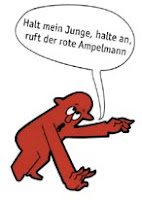I meant to write about this in connection with our trip to Germany in December, but I guess it got lost in the holiday shuffle. At any rate, Ampelmänner are back on my mind, so today you’re going to learn about them (or stop reading this post – unfortunately I haven’t found a way to force you to pay attention to me yet).
The Ampelmann, simply put, was the man on the pedestrian traffic lights in East Germany. He came into existence in the 1960s in East Berlin, and lights with his likeness were soon installed all over the country. He stands out amongst other pedestrian crossing signs because of his big hat, dramatic gesturings, and all-around adorableness. The Ampelmann was so popular that he made the jump from traffic symbol to film star in the 80s, coming to animated life in road safety movies that were compulsory viewing for school children. Thus the Ampelmann became even more loved by the East German people.
Flash forward to the 1990s, and the throws of German reunification. Actually ‘reunification’ is a misleading word, since the process was really more of an annexation. As the eastern bloc crumbled, the East German people watched much of their culture go with it. The government poured money into the East to rebuild its horribly-neglected infrastructure, trying to bring the East up to the standards of the West. The skylines of all the major cities were dominated by large cranes. Factories and consumer-goods companies closed left and right, unemployment soared, and life changed at such a fast pace that there was no time to mourn the disappearance of the country where the former East Germans had lived their entire lives.
 In the process, the new government started replacing the East German Ampelmänner with the standard, boring West German crossing lights. The Ampelmann, like so many other bits of East German life, went all but extinct during the first half of the 90s. But the East Germans were not going to let him slip away so easily. In 1996 a ‘Committee for the Preservation of Ampelmänner’ was founded, and a resistance movement began.
In the process, the new government started replacing the East German Ampelmänner with the standard, boring West German crossing lights. The Ampelmann, like so many other bits of East German life, went all but extinct during the first half of the 90s. But the East Germans were not going to let him slip away so easily. In 1996 a ‘Committee for the Preservation of Ampelmänner’ was founded, and a resistance movement began.
The manufacture of Ampelmänner was recommenced, and throughout the late 90s the beloved East German crossing lights were reinstalled in cities and towns all over the East (except on major roadways, where the ‘official’ West German traffic signal is mandated by law). This happened while I was living there. It was great fun to hear the history of the Ampelmann from various East German friends, who remembered him fondly from their childhood.
The Ampelmann is now more popular than ever, making appearances as a cult icon on all kinds of consumer goods and tourist kitsch. He even has a girlfriend, the Ampelfrau, which I have only ever seen in Dresden. Keep an eye out for them the next time you find yourself in the former GDR.
We’re big fans of the Ämpelmänner, so I was glad to see last time I was in Berlin that his impending demise had not come to pass…
I had no idea I would be this interested in walk/don’t walk figures. Bravo!
What a cute little traffic signal. I have never heard of this, but next time in former East Germany I will be sure to take a look for them!
I’ll look for him in Berlin this year! SO interesting, thanks for the post.
I have seen them on a business trip to Dresden a couple of yeears ago, but I never knew that there was such a history behind the Ampelmänner. Cool!
love the amplefrau!
Has either of the ampelvolk broken through the iron cutrain and settled in the former west? Or are they shunned as quaint and unsophisticated?
I have spotted the Ampelmann on either side of the former east/west boarder in Berlin, but never anywhere else in the west. I did read somewhere that he makes appearances as a ‘sign of solidarity’ in a handful of west German towns, but it doesn’t sound like the Wessis will ever love him as much as the Ossis (and I) do.
That’s so adorable! I wish we had those in the U.S. (Nice job with the historical/background information. Very interesting!). 🙂
I loved those bear-people things in Berlin! So much so that I would be distracted by them and nearly get run over by crossing the road.
We have those Ampelmännchen at a lot of traffic lights in Heidelberg.